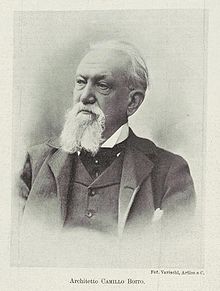Camillo Boito
Camillo Boito (born October 30, 1836 in Rome , † June 28, 1914 in Milan ) was an Italian architect and writer.
Life
Camillo Boito was born in 1836 as the son of an Italian miniature painter. He studied in Padua and then architecture at the Academy of Fine Arts in Venice. At this time he was influenced by the architect Selvatico Estense, who devoted himself to the study of medieval art in Italy. Boito taught at the Brera Academy of Fine Arts and at the Milan Polytechnic . During this time he published several magazines, for example Politecnico .
Boito played an important role in the debate about the restoration of cultural heritage. In his detailed work on the restoration of historical buildings, he tried to weigh the opposing points of view, especially those of Eugène Viollet-le-Duc and John Ruskin, and to reconcile them. This work was presented at the III Conference of Architects and Civil Engineers in Rome in 1883 and later known as the Prima Carta del Restauro . Boito's concern was a true to original preservation in relation to the identification of the original material of a building. At the same time, a “scientific” attitude towards restorations should be promoted. Boito's principles in his Essais Conservare o restaurare (Conservation instead of restoration) influenced modern legislation on the restoration and protection of historical monuments in various countries, as well as the drafting of the Charter of Athens in 1931.
Camillo Boito was married twice: in 1862 he married his cousin Celestina, from whom he separated a little later. In 1887 he married the Comtessa Madonnina Malaspina dei marchesi di Portogruaro. Camillo Boito died in Milan in 1914.
Arrigo Boito , Boito's younger brother, was a well-known poet, composer and author of the librettos for Giuseppe Verdi's last two great operas , Otello and Falstaff .
Architectural works
One of Boito's best-known works is the restoration of the Church of St. Maria and Donato on Murano according to the theories and techniques of the architect and monument conservator Eugène Viollet-le-Duc . He also worked between 1856 and 1858 at the Porta Ticinese in Milan and in 1899 at the Basilica of St. Anthony in Padua. The Gallarate cemetery was also designed by him. The most famous building in Boito is the Casa di Riposo per Musicisti , which was built from 1895 to 1899. The client was Giuseppe Verdi . The house serves as an old people's home for retired musicians and is a memorial to the composer who is buried in the crypt of the local chapel.
Literary work
Boito wrote several collections of short stories, including a psychological horror story called Notte di Natale . The tale, which bears a resemblance to Edgar Allan Poe's Berenice , is about incestuous obsession and necrophilia . A short film adaptation was released in 2012.
Around 1882 Boito wrote his most famous work Senso (Eng. Longing). The novella, which takes place in northern Italy during the Risorgimento , is about the passionate love of the Contessa Livia for an Austro-Hungarian officer who takes advantage of her, humiliates and deceives her, and who after she betrayed him in revenge for his embezzlement , is executed. The Italian director Luchino Visconti adapted Senso for the cinema, Tinto Brass in 2002. In 2011 Marco Tutino's opera based on the novel was premiered in Palermo .
Bibliography of the works of Camillo Boito (selection)
stories
- expenditure
- Storielle vane. Treves, Milan 1876.
- Senso. Nuove storielle vane. Treves, Milan 1883, ( digitized ).
- Translations
- Nostalgia. The secret diary of Contessa Livia. Novella. Translated from the Italian by Bettina Kienlechner with an afterword by Ursula März . dtv, Munich 2017, ISBN 978-3-423-28120-1 .
Essays
- Conservare o restaurare. (German: conserving instead of restoring). In: C. Boito: Questioni pratiche di Belle Arti. Restauri, concorsi, legislazione, professione, insegnamento. Hoepli, Milan 1893, pp. 1-85 .
- I nostri vecchi monumenti. Conservare o restaurare? In: Nuova antologia di scienze, lettere ed arti. Vol. 21 = Vol. 87 = Series 3, Vol. 3, 1886, ZDB -ID 211166-4 , pp. 480-506 .
Web links
- Klaus Tragbar: Fatta l'Italia, bisogna fare… a national Italian architecture in art in search of the nation. The problem of identity in Italian painting, sculpture and architecture from the Risorgimento to Fascism , Damien Dombrowski (Ed.), Lukas Verlag, 2013, Berlin (pp. 102–119) [6]
- Camillo Boito at Project Muse: Restauration in Architecture (engl.)
- Camillo Boito at Oxford Index
- Camillo Boito at Portal de Restauración (span.)
Individual evidence
- ^ [1] Carta del Restauro , Retrieved March 2, 2017
- ↑ [2] SWR, accessed on March 2, 2017
- ↑ [3] Casa Verdi, accessed on March 2, 2017
- ^ First published in Nuova antologia di scienze, lettere ed arti. Vol. 11 = Vol. 31 = Series 2, Vol. 1, 1876, ZDB -ID 211166-4 , pp. 197-210 and was republished in the Storielle vane collection in the same year . See: Edwige Comoy Fusaro: Les névroses littéraires, laboratoires d'écriture. Camillo Boito, Notte di Natale (1876). In: Cahiers de Narratologie. Vol. 18, 2010, doi : 10.4000 / narratologie.5991 .
- ↑ [4] IMDb, accessed on March 2, 2017
- ↑ [5] Der Theaterverlag, accessed on March 29, 2017
| personal data | |
|---|---|
| SURNAME | Boito, Camillo |
| BRIEF DESCRIPTION | Italian architect and author |
| DATE OF BIRTH | October 30, 1836 |
| PLACE OF BIRTH | Rome , Italy |
| DATE OF DEATH | June 28, 1914 |
| Place of death | Milan , Italy |
